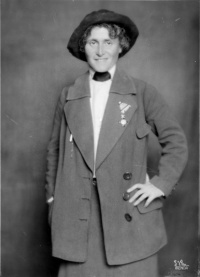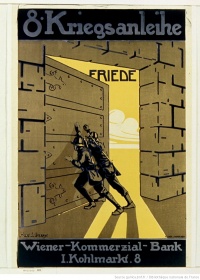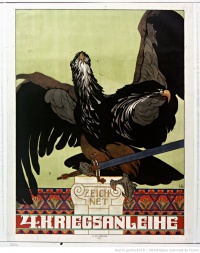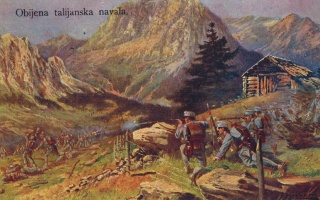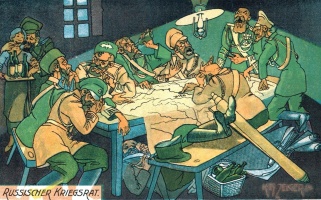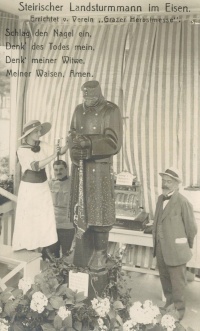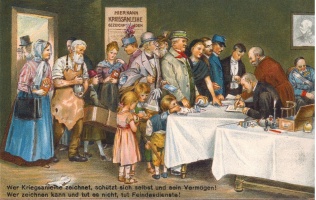Introduction↑
From early in the war, the Habsburg authorities tried to manage civilian morale through a largely uncoordinated series of patriotic initiatives, always combined with censorship in order to restrict the flow of information. By 1917, these techniques were certainly becoming more sophisticated: there was increasing awareness that managing public opinion required better coordination to match the propaganda machinery that existed in other belligerent states. Yet this was a formidable task to implement across the vast territory of the Habsburg Monarchy with its multi-lingual audiences and its division into separate (dualist) Austrian and Hungarian administrative spheres. In the summer of 1914 many enthusiastic civilians seemed to be self-mobilizing on behalf of the imperial mission, so the authorities – conceiving a short war – were not really conscious of the need for propaganda.[1] By 1917, however, many people were war weary and insecure about their future: the regime’s propaganda was now challenged by new nationalist and social movements which competed with their own enticing propaganda messages.
Journalists as Propagandists↑
In August 1914, the Habsburg leadership largely concurred on how to manage civilian morale. The priority was to win the war by suppressing all subversive elements. Therefore, special emphasis was placed on censorship rather than propaganda. Franz Conrad von Hötzendorf (1852-1925) for one always scorned the idea of trying to manipulate public opinion, but after the war he would suggest that enemy propaganda had contributed to the Monarchy’s downfall: “Propaganda is the greatest example of stupidity ever exhibited by the human race. However those who carried out this propaganda and reckoned on its effect did judge people correctly.”[2] In Austria-Hungary, it was the press which was the major tool for mass communication. In line with emergency measures introduced in July 1914, newspapers were subject to intrusive censorship. Many editors quickly adopted a policy of self-censorship, promoting an upbeat view of the war and minimizing any discordant voices.[3]
In manipulating news from the battlefields, the military authorities were particularly censorious. The imperial and royal High Command (k.u.k. AOK) ideally wanted to ban the press altogether. At best they could insist that military information from the frontline was assiduously sieved to remove anything harmful to the war effort. This function was performed by the War Press Office (Kriegspressequartier, KPQ), first established on 28 July 1914 as an AOK subsection.[4] The KPQ began in an improvised fashion under Oberst Maximilian von Hoen (1867-1940); it was based in Galicia or Moravia before moving to Vienna in November 1916. From then it assumed a more active character under Oberst Wilhelm Eisner-Bubna (1875-1926), expanding into a huge press and propaganda organization.[5]
In tune with the AOK’s paranoia about journalists, the war correspondents attached to the KPQ were kept as far away as possible from the front as it shifted back and forth. All reporters were nominated by their newspaper editors and divided at the KPQ into Austrian and Hungarian sections, where German and Hungarian were the officially approved languages. The correspondents were carefully vetted and the army leadership remained in full control. Daily, the AOK press officer composed a dry army report and sent it through to the journalists. Their main task was simply to embellish this official report and send it on to their respective newspapers in the hinterland. If most KPQ journalists felt a solemn duty to their readers, many felt a special publicity role in tying together the front and the hinterland. They saw themselves as “confidants of the public,” lending a civilian gaze to the theatres of war, but also as patriotic agents who had an obligation to uphold civilian morale.[6]
Although these two roles were not always consistent, some reporters certainly fused them together. They denied they were acting as state propagandists even though their own recruitment into the KPQ had often been facilitated by their pre-war celebrity and their potential for patriotic writing. Karl Hans Strobl (1877-1946) for instance was a celebrated novelist, who never strayed far from his patriotic brief, but typically tried to explore the parameters of his new medium. While his colourful memoirs suggest how he tried to convey some truth to his audience, he could do so more independently only by 1916 when the KPQ shifted its conception of “propaganda” and allowed him actually to tour the Italian front; the result was Der Krieg im Alpenrot, a travelogue characterized by heroism and endurance in a forbidding mountainous landscape.[7]
This difficult balance, of giving readers a “realistic” yet wholly uplifting picture, was even clearer in the work of Alexander Roda Roda (1872-1945), perhaps the most famous Austrian war correspondent. By early 1915, having witnessed the horrors of the Serbian and Russian fronts, he still lauded his own role as a modern chronicler of heroism. The over 700 articles which he composed for the Neue Freie Presse in Vienna highlighted above all Austro-Hungarian determination in the face of the enemy’s barbarism. Not surprisingly he was one of the key targets of the satirist Karl Kraus (1874-1936) who condemned him as an irresponsible war agitator.
Another target of Kraus, Alice Schalek (1874-1956), best encapsulates how a KPQ journalist could mediate effectively between front and hinterland, and how some army commanders came to recognize the active propaganda role that reporters could play.[8]
Here Schalek’s gender was crucial, for she posed as the ordinary citizen in the war zone. Steadily enthusing about the overall patriotic mission, she also avidly pursued it in Vienna by founding her own charity, the “Black-Yellow Cross.” By 1916 her much publicized work had opened doors at the front for other journalists. It was Schalek’s individual visits to the Italian front that reaped most propaganda rewards. From south Tyrol she described a solid army of Austro-Hungarian soldiers surviving in a magnificent landscape. From her Isonzo tour in the spring of 1916, she published a work describing the soldiers’ voluntary sacrifice against the treacherous Italians.[9]
This was the instigation for Schalek to transport her experiences into the public civilian arena. Beginning in October 1916 in Vienna, she publicized her travels, eventually drawing huge audiences to fifty public illustrated lectures in over twenty German and Austro-Hungarian cities. This overt propaganda, strongly supported by Hoen, illustrates well how the KPQ shifted its focus in the course of the war. Initially created as a centre for controlling military information in the public domain, by 1916 its leaders saw it as having a diverse remit, to manage the image of Austria-Hungary’s war and sustain civilian morale. Press censorship always remained an obsession at the AOK, but alongside this, the KPQ was one of several bodies which moved rather haphazardly in 1915 to stimulate imperial patriotism.
Managing Patriotic Initiatives↑
A familiar sight in most Austrian towns in the first half of the war was the Wehrmann im Eisen. He was a wooden military figure, set in a public location and covered in metal nails, each of which had been hammered home by a civilian in return for a donation supporting war widows and orphans. This local ritual, in which women especially could publicly acknowledge the common sacrifice binding front and hinterland, illustrates well the wartime challenge of how to manage patriotism through a mixture of state pressure and voluntary participation. After a few years the novelty of the Wehrmann would wear thin.
The same was true for more overt state initiatives like the war bonds to which civilians could subscribe, donating their savings in the optimistic hope of future profit. Eight public campaigns for war bonds took place in the course of the war, supported by colourful posters and some amusing films at the cinema. Public figures set an example: Archduke Friedrich Habsburg (1856-1936) as commander-in-chief personally subscribed to the first war loans with four million crowns respectively in Austria and Hungary.[10]
However, despite initial success (2.6 billion crowns garnered for the second Austrian campaign of May 1915), these were always diminishing returns as public enthusiasm waned. It was something of a touchstone for Czech loyalties that, already in 1914-15, Czech subscriptions to war bonds were proportionally less than German. This suggested some Czech wariness about financial over-commitment to the Habsburg war. By 1917 many Czech civilians preferred to invest in local bank securities than in increasingly uncertain imperial war bonds.[11] Elsewhere in the monarchy, a question hung over even the most patriotic citizens about the risks inherent in the war bond.
Early in the war, state propaganda initiatives had usually not been an end in themselves. Rather, patriotic propaganda emerged as a by-product of campaigns to finance the war (war bonds) or to fund charities working with the victims of the disaster. In 1914 the authorities were pleased that so many people were self-mobilizing, notably by backing local charities. But from the start most of these regional initiatives worked in tandem with direction from new state bodies set up to alleviate social and economic distress. Thus, the War Relief Office [Kriegshilfsbüro] at the Austrian Ministry of Interior produced a mass of war souvenirs to promote patriotism, including commemorative coins or even perfume wrapped up in wooden bullets. Another, the War Welfare Office [Kriegsfürsorgeamt] at the War Ministry, by 1917 had raised over 26 million crowns in cash donations from the public. Together with the Red Cross these two organizations also sold millions of patriotic postcards which then circulated between front and the Austro-Hungarian hinterland.[12] Many of the postcards showed soldiers thinking fondly of home. Others were images of front-line heroism and chivalry, communicating a shared sense of wartime purpose. The postcard, as one of the most ubiquitous forms of wartime propaganda, was never just a state preserve. They were also products of private printing businesses, sometimes carrying images that exceeded official messages (e.g. ruthlessly satirizing the Russians) and catering to regional tastes in the monarchy’s different languages.
By 1915, official state propaganda became clearer since the public had to be engaged for a long war. Notable now were officially sponsored publications, which usually hailed from the War Archives [Kriegsarchiv, KA], the major imperial centre devoted to patriotic propaganda. Although the head of the KA, General Emil Woinovich (1851-1927) was mainly interested in chronicling the great military events, in November 1914 he created a special “literary group” of well-known literati like Stefan Zweig (1881-1942) and Karl Ginzkey (1871-1963) who could write stimulating narratives.[13] The result from 1915 onwards was a series of popular accounts of the war, not just as history but as a lived experience: Unsere Nordfront (1916) and Unsere Kämpfen im Süden (1917). More ambitious projects included those honouring the fallen: Auf dem Felde der Ehre, fantastically planned in 160 volumes. But the most successful was the monthly illustrated journal Donauland, published from March 1917 until the end of the war. What effect these had is hard to gauge. Since most were directed at a German-speaking audience, the propaganda impact was probably limited.[14] It depended on readers who continued to believe in a common sacrifice and accepted their community’s role in that vital struggle.
The public might have been more easily persuaded via visual images, for here propaganda could be mixed with entertainment to relieve boredom on the home front. This work gained special attention from Hoen who was keen to depict the war visually as well as in word. One method was via the sophisticated use of photography, with the KPQ manipulating and propagating in its publications uplifting images of life at the front.[15] Another was via the work of war artists. From the start in 1914 Hoen had organized at the KPQ a special group of war artists, who unlike journalists were allowed to visit the frontline and record what they saw. Most of their pictures were dispatched to the KA, to be catalogued and displayed in public art exhibitions. Until April 1917 this became one of the KA’s major tasks. By May 1917, 7,441 works of art had been painted and the KA had organized 16 public exhibitions across Austria-Hungary. The first, with over 500 pictures by forty artists, had been held in October 1915 in Vienna and then Budapest.[16] In 1916 there were further exhibitions in Graz, Zagreb, Salzburg, Innsbruck, and Prague with special posters to attract the public.
Despite these clear efforts to propagate a holistic message across the monarchy, most of the 150 official war artists identified as German-Austrian (with some Magyar, Czech, and Polish exceptions). As usual, a dangerous divide prevailed between how to portray and propagate the imperial war (with its German overtones) alongside regional cultural perceptions. The tendency to have a Viennese focus was only too evident. Thus, in May 1916 it was in Vienna that the KPQ secured a location for permanent art displays. From July 1916, the famous Prater park hosted the only major war exhibition of its kind in the wartime Monarchy.[17] This enormous Austrian undertaking was a massive complex of over forty display halls, each seeking to portray an empire confidently working in unison. Here the visitors – 500,000 in the first two months – could tour recreations of the battle trenches and admire the state’s care for war invalids, or the sacrifice made by ordinary citizens in their donations of material goods to the war effort. The war mission was being marketed, but the end result was probably mainly entertainment for a bored Viennese population. Most notably, there was a disjuncture between the proclamation of unity – since Hungary refused to take part – and the reality of increasing discontent. Many visitors by late 1916 must have begun to question how far the state could really protect them and how keen they were for sacrifice. By mid-1918 this exotic exhibition had been forgotten. It was suitably replaced by one for the starving Viennese, showing them the goods they could now substitute for their most basic daily requirements.
Film as Propaganda↑
For many civilians it was cinema which fast became the most exciting form of wartime entertainment. As a fledgling medium, moving images had enormous potential to shape public opinion on the home front, and their propaganda value was slowly realized by the authorities.[18] By 1915 Vienna and Budapest both had about 150 cinemas each; cities like Zagreb, Kolozsvár, and Pozsony all had half a dozen film venues, while the number in Prague doubled to 35 by the end of the war. In April 1918, when the head of the KPQ described the cinema’s significance for state interests, he noted how the phenomenon had grown annually across the monarchy, such that a good film typically played in 3,000 venues to an audience of over 10,000 people. He lauded the real potential of film as a means of propaganda for the masses. It was a late realization that, in contrast with written propaganda, and even more than paintings or still photographs, cinema could excite all levels of society and might serve as a tool for neglected civic education.[19]
The war witnessed an expansion of film studios, with some enterprising directors seeking to use the medium in new ways to stimulate patriotism. This meant producing Austrian film dramas that were subtle propaganda vehicles like The Dream of an Austrian Reservist (1916), while in Hungary there was the opportunity to mesh popular Magyar culture with the common struggle. Thus in 1916 Alexander Korda (1893-1956) made The Grandmother and in 1918 he filmed The Golden Man, Mór Jókai’s (1825-1904) classic novel about the Turkish occupation of Hungary.
Alongside these independent initiatives, the military authorities had realized early on the need to manage film, firstly to censor images of the war, secondly after 1915 to cultivate solidarity between front and hinterland. As with the war artists, Hoen managed this as a joint KPQ-KA operation until May 1917 when all was subordinated to the KPQ in a special film department. In August 1914 Hoen gained AOK consent for establishing ten film branches in the war zones, devolving this activity to three major film companies. The most notable was that run by Alexander (“Sascha”) Kolowrat-Krakowsky (1886-1927). Already by late 1914 Sascha-Film was producing its own weekly digests of military news to be distributed to domestic cinemas. When in August 1915 authorities felt that sharper centralization was required for war film propaganda, it was Sascha-Film that secured major control. In 1916-17 Kolowrat secured an unrivalled monopoly over Austro-Hungarian film production.[20] Since cinemas could never show the raw realities of the frontline, the Sascha films – as with KPQ still photography – provided a sanitized picture. They showed the everyday life of heroes on the Alpine front, while at home the image was of an efficient patriotic machine working systematically in tandem. Later films such as Das Kind meines Nächsten (April 1918) suggested the responsibility of all citizens in caring for their children and the post-war generation.[21] Others did much to publicize the devotion of the new imperial couple, Charles I, Emperor of Austria (1887-1922) and Zita, consort of Charles I, Emperor of Austria (1892-1989) their tours of the empire and his sacrifice as the “first Habsburg soldier.” Charles, even if suspicious about new-fangled techniques for marketing the Habsburg dynasty, was far more alert than Francis Joseph I, Emperor of Austria (1830-1916) to film’s possibilities. A KPQ meeting in July 1917 stressed how film propaganda since Charles’ accession to the throne had deliberately sought to disseminate the dynastic image as widely as possible.[22]
In May 1917 major changes took place in state film organization. Although the “Sascha” title remained on many films, Kolowrat himself renounced participation because of increased military interference. This was just one move under Emperor Charles' new regime of attempting to coordinate more tightly the machinery of censorship and propaganda. It was now Hoen’s efficient deputy Wilhelm Eisner-Bubna who assumed greater KPQ control. In early 1917, the KPQ was transferred to Vienna, and Eisner-Bubna, officially appointed its head, proceeded to rationalize and expand the whole apparatus. War correspondents like Strobl, now housed near Baden, noticed a growing militarised tone.[23] Eisner-Bubna had big ambitions to create in the empire an all-embracing Ministry of Information. Certainly, he manically expanded the KPQ in all directions so that his team in Vienna grew to 900 by the end of the war. It diversified its activity into twelve main sections. While the new film department coordinated war film propaganda, the work of the war artists was promoted more efficiently by a special “propaganda group” producing brochures and art exhibitions. Much of this material was composed by a new KPQ press group. Since the work of war correspondents at Baden was now confined to frontline reporting, the press group had responsibility for editing military news and distributing it to the press at home and abroad.
Despite the huge diversification, the result was an enormous bureaucracy which probably focused too much on the mechanics of distributing information than on actually cultivating its propaganda audience. Most fundamentally, Austria-Hungary’s “propaganda apparatus” was fast losing control of events and finding its authority challenged across the empire. Firstly, Charles' new constitutional regime in Austria helped undermine the earlier strict censorship. Secondly, this coincided with sinking morale on the home front, where war weariness was rife in all quarters.
Enemy Propaganda Defence↑
It is striking evidence of the anxious mindset of Habsburg-loyal individuals in 1918 that they turned increasingly towards “enemy propaganda defence.” Thrown onto the defensive, they realized the need to act against new threats to morale and imperial stability. These came on the one hand from within, in the form of nationalist and social movements; and on the other from without, in new ideological offensives stemming from both the East and West. Ironically, this was precisely the period when extra coordination of the propaganda machinery was being attempted. The KPQ was trying to centralize control over propaganda, but its resources were weak in terms of money for film, or paper for publications. Most crucial was the disjuncture between the new military focus of the KPQ and the Czech or Polish nationalist agendas now operating quite freely and spreading a contrary message among the civilian population.
From late 1917, in military eyes, the major propagator of subversive ideas across the monarchy was the domestic press, for under parliamentary pressure the Austrian government had been forced to concede a far laxer censorship. The AOK sought to keep the army in quarantine. But on 14 March 1918, spurred on by the example of “patriotic instruction” in the German armed forces, it created a special organization in Vienna with the offensive remit of trying to uphold military morale. The context for this body was not just the AOK’s nervousness about a home front awash with strikes and nationalist agitation, but its sudden appreciation of “propaganda” as a modern weapon of total warfare.[24] Referring to subversive threats at home and abroad, the Enemy Propaganda Defence Agency [Feindespropaganda-Abwehrstelle, FAst] was born. The FAst had a purely military purpose, to sustain morale in the armed forces, but civilians might also be indirectly encouraged to hold out. After all, the way that domestic propaganda had evolved during the war had revealed front and hinterland to be closely interlinked. The FAst leadership showed awareness of this in its intensive teacher-training courses held in Vienna and Budapest. Some civilian experts were used as teachers: Karl Werkmann (1878-1952) spoke about the Habsburg dynasty, while the historian Hans Übersberger (1877-1962) about the Russian revolution.
Yet when it came to sustaining morale on the home front, the military by 1918 were hampered by political restrictions from intervening beyond some basic censorship and were forced to rely largely on the existing KPQ apparatus. Many complained to the FAst that some domestic propaganda organization was vitally necessary, but only in the summer of 1918 were there signs that the Austrian Ministry of Interior was contemplating a new initiative. In early October, the Ministry finally decided to launch a civilian propaganda centre with the aid of the FAst and the KPQ. Eisner-Bubna, however, was not optimistic. A meaningful message of state patriotism, he felt, would now be extremely hard to coordinate. Notably also, it would not include the Hungarian half of the empire.
Conclusion↑
Despite these last minute initiatives, in the final years of the war the Habsburg authorities had not been complacent about the threats to domestic morale and patriotism. They understood that propaganda was a crucial tool for encouraging all citizens to continue participating in the war. Austro-Hungarian propaganda methods were also becoming more sophisticated under KPQ guidance. Yet it was the fundamental questions of socio-economic and regional insecurity that the Habsburg authorities could never solve. From mid-1917 they had lost the battle over censorship of information; and the KPQ, despite its reinvigoration, was unable to supply a credible patriotic message. Indeed, when it came to propaganda, the authorities in 1918 were returning to the mentality of 1914, hoping to keep control by stopping the circulation of subversive ideas. This could no longer be achieved. Against the many patriotic citizens who still hoped for victory, there were many more who wanted peace at all costs and put their trust in the security offered by new regional and nationalist governments in Prague, Zagreb, or Budapest. Consistently, Habsburg propaganda efforts had shown the difficulty of creating a holistic imperial message across a breadth of national and social interests. By 1918 that message was disintegrating because, in the face of mass insecurity and military defeat, the Habsburg Monarchy itself was losing its legitimacy in the eyes of many of its citizens.
Mark Cornwall, University of Southampton
Section Editors: Richard Lein; Gunda Barth-Scalmani
Notes
- ↑ See Cornwall, Mark: The Spirit of War in Austria-Hungary. In: Prispevki za novejšo zgodovino LV/2 (2015), pp. 7-21.
- ↑ Quoted in Regele, Oskar: Feldmarschall Conrad. Auftrag und Erfüllung 1906-1918, Vienna and Munich 1955, p. 99.
- ↑ Scheer, Tamara: Die Ringstraßenfront. Österreich-Ungarn, das Kriegsüberwachungsamt und der Ausnahmezustand während des Ersten Weltkrieges, Vienna 2010, pp. 108-129.
- ↑ Stiaßny-Baumgartner, Ilse: Roda Rodas Tätigkeit im Kriegspressequartier. Zur propagandistischen Arbeit österreichischer Schriftsteller im ersten Weltkrieg, PhD diss., Vienna 1982, p. 4. See also for the War Press Office, Mayer, Klaus: Die Organisation des Kriegspressequartier beim k.u.k. AOK im ersten Weltkrieg 1914-1918, PhD diss., Vienna 1963.
- ↑ Lustig-Prean, Karl: Aus den Geheimnissen des Kriegspressequartiers. In: Neues Wiener Journal 21 (April 1920), p. 4.
- ↑ Stiaßny-Baumgartner, Roda Rodas Tätigkeit 1982, pp. 154, 190.
- ↑ See Strobl, Karl Hans: Der Krieg im Alpenrot. Berlin and Vienna 1916. Also Strobl’s memoirs: K.P.Qu, Geschichten und Bilder aus dem österreichischen Kriegspressequartier, Reichenberg 1928; Die Weltgeschichte und das Igelhaus. Vom Nachmittag des Lebens. Die Erinnerungen III, Budweis and Leipzig 1944.
- ↑ See Rapp, Christian: “Das Ganze ist so grandois organisiert….”. Der Weltkrieg der Alice Schalek, in: Krasny, Elke / Patka, Marcus / Rapp, Christian / Rapp-Wimberger, Nadia (eds.): Von Samoa zum Isonzo. Die Fotografim und Reisejournalistin Alice Schalek, Vienna 1999.
- ↑ Schalek, Alice: Tirol in Waffen. Kriegsberichte von der Tiroler Front, Munich 1915; Schalek, Alice: Am Isonzo. März bis Juli 1916, Vienna 1916.
- ↑ Rauchensteiner, Manfried: Der Erste Weltkrieg und das Ende der Habsburgermonarchie 1914-1918. Vienna-Cologne-Weimar 2013, pp. 435-436, 585-597.
- ↑ Šedivý, Ivan: Češi, české země a velká válka 1914-1918. Prague 2001, pp. 239-243.
- ↑ Burgschwentner, Joachim: War Relief, Patriotism and Art: The State-Run Production of Picture Postcards in Austria 1914-1918, in: Austrian Studies 21 (2013), pp. 99-120.
- ↑ See Peball, Kurt: Literarische Publikationen des Kriegsarchivs im Weltkrieg 1914 bis 1918. In: Mitteilungen des Österreichischen Staatsarchivs, Band 14 (1961), pp. 240-260.
- ↑ Ibid., p. 257.
- ↑ The best study is Holzer, Anton: Die andere Front. Fotographie und Propaganda im Ersten Weltkrieg, Darmstadt 2007.
- ↑ See for example Kriegsarchiv Vienna, Nachlass Hoen, 46/1, ‘Genossenschaft der Bildenden Künstler to Hoen,’ 6 October 1915.
- ↑ See Healy, Maureen: Vienna and the Fall of the Habsburg Empire. Total War and Everyday Life in World War I, Cambridge 2004, pp. 87-90, 107-120.
- ↑ For film as propaganda, see Büttner, Elisabeth and Dewald, Christian: Das tägliche Brennen. Eine Geschichte des österreichischen Films von den Anfängen bis 1945, Salzburg and Vienna 2002; Cunningham, John: Hungarian Cinema. From Coffee House to Multiplex, London and New York 2004; von Dassanowsky, Robert: Austrian Cinema. A History, Jefferson and London 2005.
- ↑ Quoted in Büttner and Dewald, Das tägliche Brennen 2002, pp. 192-194.
- ↑ Ibid., pp. 184-186.
- ↑ Ibid., pp. 145, 154-157.
- ↑ Ibid., p. 150.
- ↑ Strobl, Die Weltgeschichte und das Igelhaus 1944, pp. 55, 200.
- ↑ Cornwall, Mark: The Undermining of Austria-Hungary. The Battle for Hearts and Minds, second edition, New York 2018, pp. 268-287.
Selected Bibliography
- Büttner, Elisabeth / Dewald, Christian: Das tägliche Brennen. Eine Geschichte des österreichischen Films von den Anfängen bis 1945, Salzburg; Vienna 2002: Residenz Verlag.
- Cornwall, Mark: The undermining of Austria-Hungary. The battle for hearts and minds, New York 2000: St. Martin's Press.
- Cornwall, Mark: Das Ringen um die Moral des Hinterlandes, in: Rumpler, Helmut / Schmied-Kowarzik, Anatol (eds.): Die Habsburgermonarchie 1848-1918. Die Habsburgermonarchie und der Erste Weltkrieg, volume 11, part 1, Vienna 2016: Verlag der Österreichischen Akademie der Wissenschaften, pp. 393-435.
- Healy, Maureen: Vienna and the fall of the Habsburg Empire. Total war and everyday life in World War I, Cambridge 2004: Cambridge University Press.
- Holzer, Anton: Die andere Front. Fotografie und Propaganda im Ersten Weltkrieg. Mit unveröffentlichten Originalaufnahmen aus dem Bildarchiv der Österreichischen Nationalbibliothek, Darmstadt 2007: Primus.
- Rauchensteiner, Manfried: Der Erste Weltkrieg und das Ende der Habsburgermonarchie 1914-1918, Vienna et al. 2013: Böhlau.
- Reichel, Walter: 'Pressearbeit ist Propagandaarbeit'. Medienverwaltung 1914-1918. Das Kriegspressequartier (KPQ), Innsbruck 2016: Studien Verlag.
- Roshwald, Aviel / Stites, Richard (eds.): European culture in the Great War. The arts, entertainment, and propaganda, 1914-1918, Cambridge; New York 1999: Cambridge University Press.
- Scheer, Tamara: Die Ringstraßenfront. Österreich-Ungarn, das Kriegsüberwachungsamt und der Ausnahmezustand während des Ersten Weltkrieges, Vienna 2010: Heeresgeschichtliches Museum.
- Strobl, Karl Hans: Die Weltgeschichte und das Igelhaus. Vom Nachmittag des Lebens. Der Errinnungen, volume 3, Budweis; Leipzig 1944: Verlagsanstalt Moldavia.
- Weigel, Hans / Lukan, Walter / Peyfuss, Max Demeter: Jeder Schuss ein Russ, jeder Stoss ein Franzos. Literarische und graphische Kriegspropaganda in Deutschland und Österreich, 1914-1918, Vienna 1983: C. Brandstätter.





